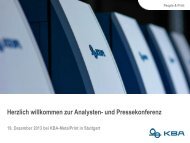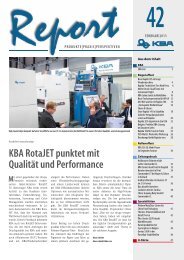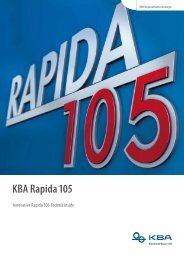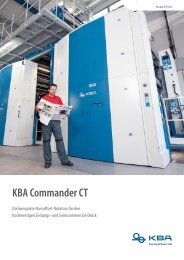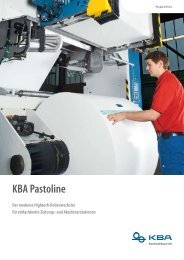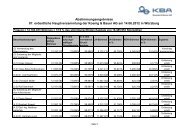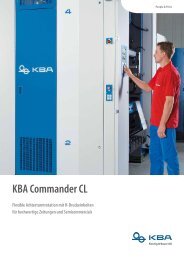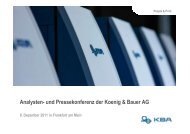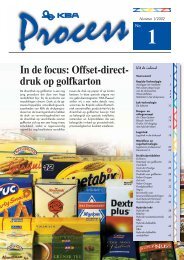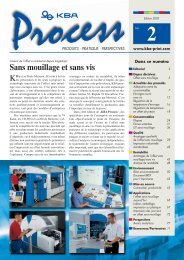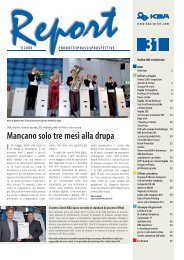Report 36 d,e,f,s,i.qxd:Report - KBA
Report 36 d,e,f,s,i.qxd:Report - KBA
Report 36 d,e,f,s,i.qxd:Report - KBA
Create successful ePaper yourself
Turn your PDF publications into a flip-book with our unique Google optimized e-Paper software.
€569.03<br />
parable press is 15% lower than for<br />
the Rapida 142 with peripherals, its<br />
hourly rate is 18% higher. The Rapida’s<br />
reduced rate is largely the result<br />
of its higher output in tandem<br />
with a fully automated, interlinked<br />
logistics system. Lower labour costs<br />
and much lower energy consumption<br />
with <strong>KBA</strong>’s VariDry dryer also<br />
helped trim costs (see article on energy<br />
efficiency, pages 22-23).<br />
When calculating the respective<br />
output levels of the two presses we<br />
took as our basis the makeready<br />
times and average run length per<br />
job. As the top right-hand graph on<br />
page 8 illustrates, a complete job<br />
change on the Rapida 142 takes just<br />
23 minutes – little more than half<br />
the time on the rival press. A major<br />
reason for this is the Rapida’s advanced<br />
level of automation and simultaneous<br />
washing cycles. Higher<br />
automation is also the reason why<br />
changes of coating, printing plates<br />
and coating plates are also much<br />
faster on the Rapida.<br />
2,300 more jobs<br />
per year<br />
Shorter makeready times mean that<br />
the Rapida can print a much larger<br />
number of jobs per shift or day.<br />
Assuming an average run length<br />
of 5,000 sheets per job, the<br />
15,000sph Rapida 142’s higher<br />
level of automation and modestly<br />
higher production speed enable it<br />
to print 2,316 more jobs or<br />
11,583,000 more sheets per year<br />
than the cheaper rival press.<br />
The two graphs at the bottom of<br />
page 8 show the output in jobs and<br />
sheets respectively on the Rapida<br />
Per-job costs<br />
Specifications <strong>KBA</strong> Rapida 142-6+coater Comparable press<br />
Plinth ☑ ☑<br />
Automated nonstop feeder ☑ ☑<br />
Automated nonstop delivery ☑ ☑<br />
Interlinked pile logistics ☑ PileTronic ☐ Not interlinked<br />
Automatic plate change ☑ FAPC ☐ Semi-automatic<br />
Washing system ☑ Blanket/impression cylinders, rollers ☑ Blanket/impression cylinders, rollers<br />
Simultaneous washing ☑ CleanTronic Synchro ☐ Not available<br />
Automatic coating plate change ☑ ☐ Manual<br />
Coating system cleaning ☑ Automatic ☐ Manual<br />
Register system ☑ Automatic Camera Register ☐ Not available<br />
Energy-efficient dryer ☑ VariDry ☐ Not available<br />
Inline colour measurement/control ☑ QualiTronic CC ☑<br />
Online PDF control ☑ DensiTronic PDF ☐ Not available<br />
Machine overheads <strong>KBA</strong> Rapida 142-6+coater Comparable press<br />
Working days per year 250 250<br />
Working hours per shift 7.4 7.4<br />
Number of shifts 3 3<br />
Gross capacity utilisation rate 300 % 300 %<br />
Net capacity utilisation rate<br />
Printing as proportion of<br />
90 % 85 %<br />
production output 90 % 85 %<br />
Makeready per job 23 minutes 45 minutes<br />
Maximum production speed 15,000 sheets/h 14,000 sheets/h<br />
Energy-efficient dryer VariDry Not available<br />
Average run length 5,000 sheets 5,000 sheets<br />
Price of press 100 % 85 %<br />
Payback period 37 months 38 months<br />
Calculated hourly rate 375 euros 443 euros<br />
142 and the comparable press for<br />
average run lengths of between<br />
1,000 and 15,000 sheets. They can<br />
be calculated individually for any<br />
printing plant.<br />
The per-job costs for the two<br />
presses depend to a large extent on<br />
output. In the graph below it can be<br />
seen that, for an assumed average<br />
run length of 5,000 sheets, the per-<br />
Comparable press <strong>KBA</strong> Rapida 142-6+coater Gain with Rapida 142<br />
Per-job costs<br />
€1,100<br />
€1,000<br />
€900<br />
€800<br />
€700<br />
€600<br />
€500<br />
€400<br />
€300<br />
€200<br />
€100<br />
€309.80 €259.23<br />
Rapida 142, cost gain<br />
€0<br />
€0<br />
10,3<strong>36</strong> 8,724 7,531 6,625 5,914 5,340 4,868 4,473 4,137 3,848 3,596 3,376 3,181 3,007 2,852 Jobs / year<br />
1,000 2,000 3,000 4,000 5,000 6,000 7,000 8,000 9,000 10,000 11,000 12,000 13,000 14,000 15,000 Ø run length (sh)<br />
€400<br />
€350<br />
€300<br />
€250<br />
€200<br />
€150<br />
€100<br />
€50<br />
job costs with the Rapida 142 are<br />
€259.30 lower than with the comparable<br />
press.<br />
No false economies<br />
While there is some truth in the<br />
much-repeated argument that a<br />
highly productive press is only<br />
worth the extra money if it is<br />
utilised to the full, it is wrong to<br />
conclude that a cheaper, less productive<br />
press is the right choice<br />
where order volumes leave a lot to<br />
be desired. This defensive investment<br />
philosophy ignores the significant<br />
cost drawback of competing<br />
with rivals whose equipment is<br />
much more productive.<br />
Pre-investment analysis<br />
The examples given, based on an average<br />
run length of 5,000 sheets,<br />
indicate that even if the initial capital<br />
cost is higher, it may still be<br />
wiser to go for a highly automated<br />
press line with correspondingly<br />
shorter makeready times. Where<br />
run lengths are generally long and<br />
there are fewer changes, makeready<br />
times necessarily play a minor role.<br />
But where short runs dominate the<br />
production schedule, and this typically<br />
applies to printers of cosmetics<br />
and pharmaceutical packaging,<br />
they can be a key factor – along<br />
with labour costs, energy consumption<br />
and waste rates – in determining<br />
economic viability. In view of<br />
the flexibility demanded today, a<br />
press that performs well on every<br />
measure may therefore prove to be<br />
the better business option. The<br />
Rapidas fit the bill.<br />
Printers’ job structures differ<br />
enormously. When contemplating<br />
the purchase of new kit, these differences<br />
can be addressed by conducting<br />
individual productivity and<br />
cost-efficiency analyses. <strong>KBA</strong> is always<br />
happy to help.<br />
Jürgen Veil<br />
juergen.veil@kba.com<br />
<strong>Report</strong> <strong>36</strong> | 2010 9




